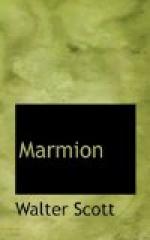’The last occasion on which the Champion officiated was at the coronation of George iv.’—’Notes and Queries,’ 7th S. III, 236.
line 161. mark, a weight for gold and silver, differing in amount in different countries. The English coin so called was worth 13s. 4d. sterling.
line 163. ’This was the cry with which heralds and pursuivants were wont to acknowledge the bounty received from the knights. Stewart of Lorn distinguishes a ballad, in which he satirises the narrowness of James V and his courtiers by the ironical burden—
“Lerges, lerges,
lerges, hay,
Lerges of this
new year day.
First lerges of
the King, my chief,
Quhilk come als
quiet as a theif,
And in my hand
slid schillingis tway1,
To put his lergnes
to the preif2,
For lerges of
this new-yeir day.”
1two 2proof
’The heralds, like the minstrels, were a race allowed to have great claims upon the liberality of the knights, of whose feats they kept a record, and proclaimed them aloud, as in the text, upon suitable occasions.
’At Berwick, Norham, and other Border fortresses of importance, pursuivants usually resided, whose inviolable character rendered them the only persons that could, with perfect assurance of safety, be sent on necessary embassies into Scotland. This is alluded to in Stanza xxi. p. 25.’—Scott.
line 165. Blazon’d shield, a shield with a coat of arms painted on it, especially with bearings quartered in commemoration of victory in battle. See below V. xv, vi. xxxviii, and cp. Tennyson, ’The Lady of Shalott,’ Part 3:—
’And from his
blazon’d baldric slung
A mighty silver
bugle hung.’
line 174. The Cotswold downs, Gloucestershire, were famous as a hunting-ground. Cp. Merry Wives of Windsor, I. i. 92, ’How does your fallow greyhound, sir? I heard say he was outrun on Cotsall.’
line 185. The reversed shield, hung on the gallows, indicated the degraded knight.
Stanza xiii. line 192. Scott writes:—’Were accuracy of any consequence in a fictitious narrative, this castellan’s name ought to have been William; for William Heron of Ford was husband to the famous Lady Ford, whose syren charms are said to have cost our James iv so dear. Moreover, the said William Heron was, at the time supposed, a prisoner in Scotland, being surrendered by Henry VIII, on account of his share in the slaughter of Sir Robert Ker of Cessford. His wife, represented in the text as residing at the Court of Scotland, was, in fact, living in her own castle at Ford.—See Sir Richard heron’s curious Genealogy of the Heron Family.’




